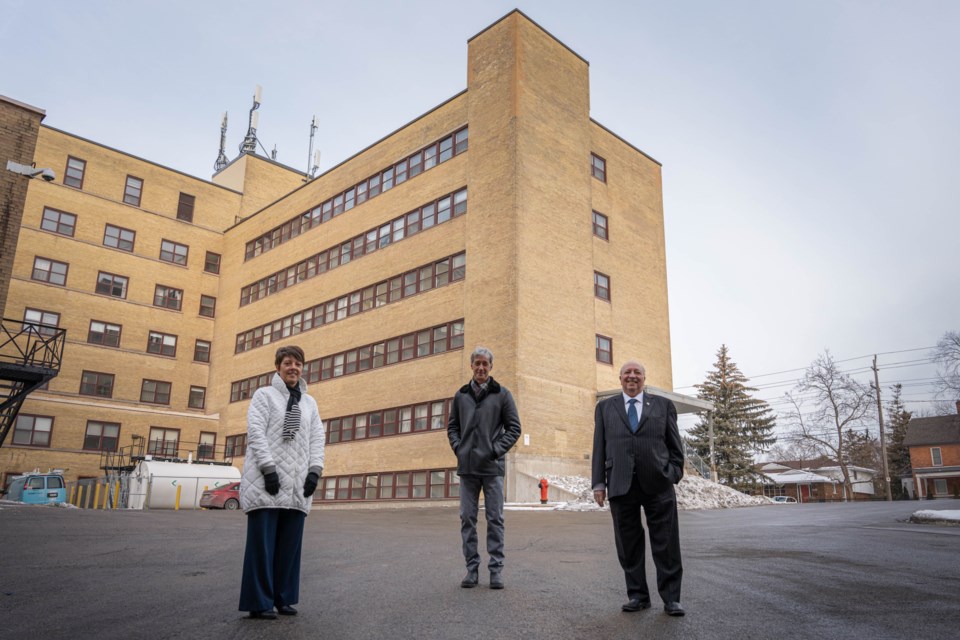Tara Jeffrey
After decades of pleading for better addiction treatment locally the hard-fought battle was won Tuesday when Ontario announced plans for a 24-bed ‘Community Addictions Hub’ in Sarnia.
“It’s been a perpetual roller coaster,” Mayor Mike Bradley said of the wait for facility funding to address Sarnia-Lambton’s growing and crippling addiction crisis.
Sarnia-Lambton MPP Bob Bailey announced a $12-million commitment during a news conference at Bluewater Health, where the facility will operate around the clock, seven days a week in a currently vacant hospital wing facing Russell Street and London Road.
“The day we’ve all been waiting for has finally arrived,” Bailey said. “Thank you to all the members of the community who wrote letters and emails, signed petitions, made phone calls and worked relentlessly to make this idea become a reality.”
The Addictions Hub will have 10 withdrawal management beds, eight observation beds, and six stabilization or transition beds, along with clinical space for programs, treatment, and outpatients services.
The focus is on early-stage recovery, said Paula Reaume-Zimmer, the hospital’s integrated vice president of mental health and addiction services.
“There is a misunderstanding in the community about the additions hub, and the 24 beds, compared to a rehabilitative centre like Westover [Treatment Centre] or Brentwood [Recovery Home].
“These beds are targeted to respond to the early stages of recovery — and we’ll still be working closely with our regional partners to support longer term treatment that’s required.”
The project now moves to the planning, tender and design phase, said Bluewater Health president and CEO Mike Lapaine.
“We hope that in less than two years we should be under construction,” he said, noting the pandemic has exacerbated addition problems.
“We see a significant number of drug-related arrests, higher rates of housing vulnerability, a high usage of crystal meth and prescription opioids, and a strong culture of drinking and marijuana use,” he said.
Demand for help at the hospital has risen 20% over four years, and up to a dozen requests for beds are turned down each day, said Paula Reaume-Zimmer.
“Sometimes that includes someone calling several times, but it still demonstrates the desperation for access to a bed,” she said.
It’s heartbreaking for staff as well, she added, “When they hear the pain in their tone when they’re asking for a bed, when they’re finally courageous enough to reach out.”
Residents, community leaders and hospital officials have long pushing for such a facility, initially requesting $8.5 million from the province. But the process appeared to have stalled.
In 2018, the province provided $445,000 to open a temporary seven-bed unit on the hospital’s 6th floor, which “barely scratched the surface” of the opioid crisis, Sarnia Police Sgt. John Pearce said at the time.
Last year, Ontario announced $700,000 in annual base funding for Ryan’s House, a 12-bed ‘stabilization and transition facility’ to augment the temporary unit.
The home, which has supported 90 individual clients to date, is named for Ryan Hicks, who died of a fentanyl overdose in March 2015,
“I’m having a hard time not jumping out of my chair right now,” said Ryan Hicks’ mother Laurie Hicks, a tireless local advocate for addiction services. “To know that the wait is not going to be there any more — that there’s going to be a place to save a life — is huge.”
In December, more than 2,000 people signed a petition launched by the Community Law School Sarnia-Lambton Social Justice Advocacy Group — calling for the government to immediately release funding for the facility.
The former District Health Council first identified the need for a ‘community detox centre’ in Sarnia back in the late 1980s and early 1990s.
“There was a facility on Essex Street back in the 1980s but it closed,” said Mayor Bradley, who worked with former MP Pat Davidson to secure a building in the 1990s, “but had no funding.”
Bradley said he began lobbying for a standalone facility after learning a woman in downtown Sarnia had died drinking turpentine to get high.
“It just stunned me; what facilities do we have? The running joke in the community was, sadly, ‘we do have a detox centre — it’s the Sarnia jail,” he recalled.
“But we’re here today. Now the key is to get it built and operational.
“We all know people who have lost their lives,” he added. “It was way too long of a journey.”
